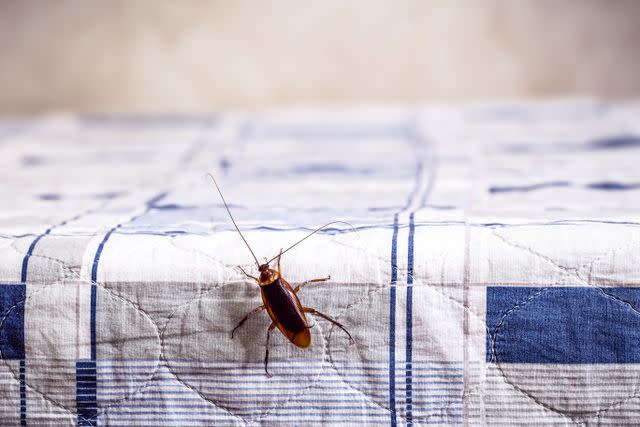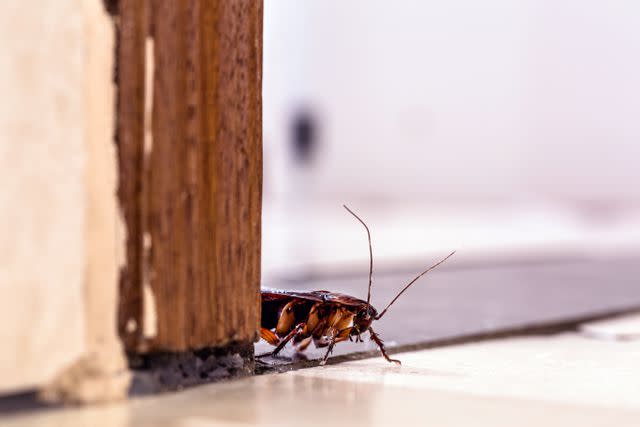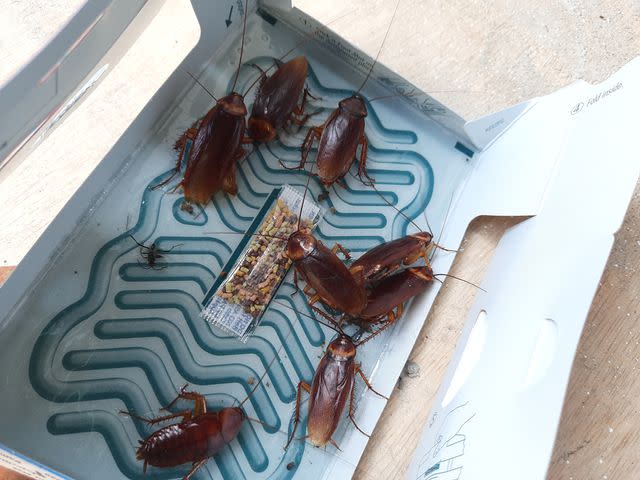How To Keep Cockroaches Away And Get Rid Of Them Around Your Home, According To Experts
Here’s how to get control of these disease-carrying pests.
Like termites, cockroaches have a job to do, breaking down organic matter in the natural world. But even one cockroach isn’t acceptable indoors. “They don’t vector, or directly transmit, diseases like a tick or mosquito, but they can mechanically transfer pathogens that cause illnesses such as e. coli and salmonella,” says Eric Benson, PhD, professor emeritus and extension entomologist at Clemson University. “For example, they crawl up from the drain or sewer carrying germs, then walk across food or food preparation surfaces.” They also can defecate or regurgitate pathogens on surfaces.

Getty Images
In addition, research has shown cockroach debris, such as feces and shed skins, can cause allergies and asthma in some people. “There’s a proven connection between the allergens they shed and asthma,” says Faith Oi, PhD, entomologist and extension professor at the University of Florida. “One study showed that when you suppress cockroach populations, the proteins that cause allergic reactions drop below a level that triggers asthma attacks.”
Meet The Expert
Eric Benson, PhD, is professor emeritus and extension entomologist at Clemson University.
Faith Oi, PhD, is an entomologist and extension professor at the University of Florida.
Types Of Cockroaches
While there are more than 4,000 species of cockroaches in the world, the most troublesome in the Southeast are three types, says Benson:
· American cockroaches, which are about 1 ½ to 2 inches in length when adults, are a red-brown color with yellow markings behind the head.
· Smokybrown cockroaches are about 1 to 1 ¼ inches long as adults and are brown in color.
· German cockroaches, which are ¼ to 3/8 inches long and pale brown or tan with two dark streaks behind the head. “German cockroaches are the biggest pests worldwide,” says Oi. “They are spread entirely by humans and live only in association with people.”
Another type of cockroach you may hear people talk about in the South is palmetto bugs. Actually, that’s just a more “polite” name for large cockroaches such as Americans and smokybrowns. “It may have come from the fact that smokybrowns are naturally found in trees, such as palmetto trees,” says Benson. But, in truth, a palmetto bug is a cockroach!

Getty Images
American CockroachHere’s how to keep all kinds of cockroaches out of your home and what to do if you see them:
How To Keep Cockroaches Out Of Your House
“Once cockroaches get in, they’ll do everything they can to survive. They’re one of the oldest insect groups on the planet and are very adaptable,” says Benson. “The number one rule is to keep them out in the first place.” Here’s what you can do to make your home less appealing:
· Remove thick mulch, vegetation and wood piles up against your home’s foundation. Trim tree limbs and shrubs so they don’t touch your house and provide easy access. American and smokybrowns especially like this sort of environment, says Benson.
· Keep screens and weather stripping in good repair. Caulk holes around plumbing and sewer lines.
· Don’t leave pet food bowls out overnight, either indoors or out, says Benson.
· Clean up pet waste every day. “One reason cockroaches are so successful is that they’re omnivores and opportunistic. They will eat anything, including feces,” says Benson. Side note: They’ll also eat items as varied as the glue in plywood and books and each other!
· Keep garbage cans and recycling bins clean. Seal garbage tightly in bags, and rinse out bottles and cans before placing in recycling bins. Keep these containers clean and away from your home in a dry location because cockroaches also need water to survive. The combination of food debris and moisture in these containers can provide safe harborage, says Benson.
· Inspect boxes and bags when bringing them into your home. Eggs or young cockroaches may be hiding in them. They’re especially fond of cardboard, says Oi.
· Check secondhand furniture, firewood, and anything else you bring indoors for signs of cockroaches before bringing inside. Even backpacks, purses, and clothing can carry cockroaches indoors, says Oi.
· Store items that you’re keeping long-term, such as Christmas decorations, in plastic containers, not cardboard boxes.
· Practice smart sanitation. Keep food in sealed containers. Clean up all spills and crumbs as they occur. Wiping down surfaces with warm, soapy water and a clear water rinse also removes any chemical markers cockroaches leave behind that signal to other cockroaches that this is a good place to hang out, says Oi.
· Clean up clutter. Yet another reason to de-junk your home: Roaches like to hide in piles of cardboard, papers, and rags, says Benson.
How To Tell If You Have Cockroaches
Obviously, if you see one scuttling across the floor, you have an issue. “Where there’s one, there’s probably more,” says Benson. But because they spend most of their time sheltering in out-of-the-way locations, it may take some sleuthing to locate their hide-outs.
Cockroaches like to be near sources of food and water, wedging themselves in cracks and crevices with their backs and fronts touching a surface, says Oi. Favorite hiding spots include behind drawers, cabinets and baseboards; behind or under stoves, sinks, fridges, and dishwashers; in laundry rooms, and in crawl spaces. Use a flashlight and mirror to look in difficult spots.
Other signs you have an issue: If you see them during the daytime (because they’re nocturnal, this may indicate a sizable infestation); if you smell a strange odor, which is often described as oily or musty; or if you see a white or “albino” cockroach. “These aren’t actually albinos,” says Oi. “It’s actually a cockroach that just molted and is waiting for its exoskeleton to harden. This may be a particularly bad sign because if it’s in plain view, it may mean all the ‘good’ hiding spots are taken by other cockroaches.”
Related: How To Keep Flies Away From Your House
How To Get Rid Of Cockroaches
Anyone’s home can become infested, so don’t feel embarrassed if you see these pests indoors, says Benson. There are several steps you can take to get rid of cockroaches:
· Set up sticky traps, or “monitoring stations,” near where you’ve spied them. This will help you figure out where they’re concentrated, says Oi. One to a few adults trapped indicates it’s probably a new infestation; many different life stages trapped means it’s a more established infestation.
· If you catch cockroaches in your traps, set out baits in that area. Baits contain insecticide that may not only kill the roach who ingests it but that has a secondary transfer to other roaches who may eat that roach’s waste or the roach itself, says Benson. Obviously, keep these out of the reach of kids and pets.
· Use baits correctly. “Use pea-sized drops of gel bait, not a whole line, like caulking,” says Oi. Place the drops about 12-inches apart five feet on either side of the trap. Look for baits that contain an insect growth regulator (IGR), which affects their reproductive abilities. Bait stations are okay, too, but if you forget where you’ve placed them or don’t replace them regularly, they can become harborage for cockroaches.
· Insecticidal dusts are effective for inaccessible areas of your home, such as wall voids or around electrical outlets, says Benson.
· Keep the sticky traps out to monitor your success. Replace when the sticky area is covered.
· Rotate the type of product used regularly. That’s because cockroaches have a high degree of insecticide resistance. Look for a different active ingredient (preferably in a different class of insecticides), not just a different product, says Oi. Product rotation slows down the development of insecticide resistance. Your local university county coop extension service can offer additional guidance (find yours here).
· Hire a professional pest control company. If you don’t feel up to tackling this yourself or you’re not getting control after a few months, hire a pest control company, which has access to additional products and tools and can do a thorough inspection, says Benson. Take your time and interview two to three different companies. But be wary of any bids that are out of line with others, especially any that are very low.

Getty Images
Do Repellants Keep Cockroaches Away?
Despite what you’ve heard, DIY repellants don’t keep cockroaches away. That goes for fabric softener, coffee grounds, bay leaves, and sonic repellant devices, which have no scientific basis.
Ditto for essential oils. “You’d have to spray an essential oil directly on the individual cockroach, which isn’t going to provide lasting control,” says Oi. “Why not just use a bait that will kill it and provide secondary transfer to other cockroaches?”
In addition, sprays and foggers are not recommended due to the issue of pesticide resistance. Also, most of the insecticide will end up on surfaces where it’s more likely to be in contact with people and pets, rather than in the nooks and crannies where roaches like to hide, says Oi.
For more Southern Living news, make sure to sign up for our newsletter!
Read the original article on Southern Living.

